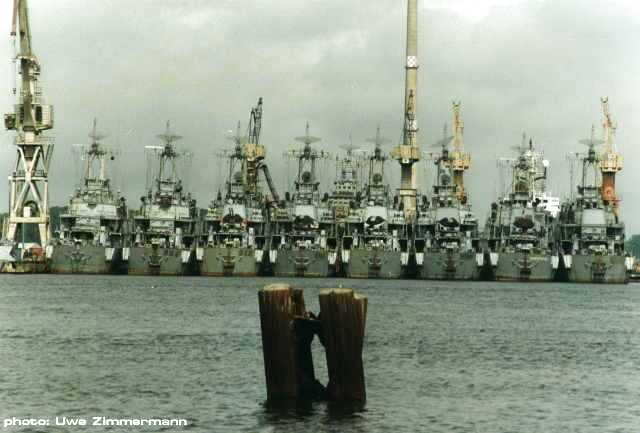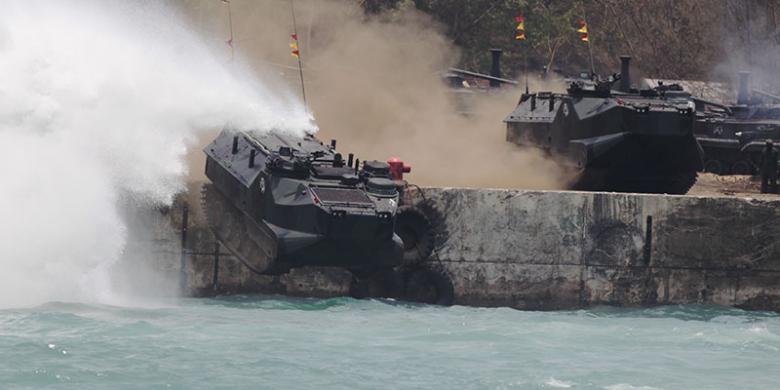Judul : Used 'alutsista': Warships That Safeguard Indonesian Waters
link : Used 'alutsista': Warships That Safeguard Indonesian Waters
Used 'alutsista': Warships That Safeguard Indonesian Waters
 Indonesia is the world’s largest archipelagic country with some 17,000 islands and a vast maritime territory.
Indonesia is the world’s largest archipelagic country with some 17,000 islands and a vast maritime territory.The Office of the Coordinating Maritime Affairs and Investment Minister announced in 2018 that it had updated Indonesia’s total territory to span 8.3 million square kilometers, comprising 1.9 sq km of territorial land and 6.4 million sq km of territorial waters.
The latest data was calculated by the Geospatial Information Agency (BIG) and the Hydrography and Oceanography Center (Pushidrosal) of the Indonesian Navy (TNI AL).
The BIG and Pushidrosal calculated that Indonesian had sovereignty over 3.11 million sq km of archipelagic waters and 290,000 sq km of territorial sea. Indonesia also had sovereign right over 3 million sq km of exclusive economic zone (EEZ).
The two institutions also calculated Indonesian territory also covered 270,000 sq km of contiguous zone, the maritime zone that extends 12 nautical miles beyond the territorial sea, while it had a continental shelf that covered about 2.8 million sq km.
The United Nations Statistics Division, however, acknowledges that a country's area only covers its land territory and the total surface of inland freshwater bodies, such as lakes, reservoirs and rivers. The UN Statistics Division states that Indonesia's area is 1.91 million sq km.
With its strategic location between two continents and two oceans, having a strong navy is a must as part of Indonesia’s alutsista (national defense weaponry and systems) to secure and defend its maritime borders. The government decided in the past that it would take advantage of used warships from other countries that had been decommissioned.
The most controversial procurement of secondhand warships was in 1992, when Indonesia bought several warships formerly operated by the East German Navy, the Volksmarine. The controversy was over not only the warships’ technical specifications, which were not designed for operating in tropical waters, but also their value, with many suggesting that the price had been inflated.
The US$ 482 million deal procured 39 naval vessels consisting of three types: antisubmarine warfare (ASW) corvettes, landing ship tanks (LSTs) and minesweepers. All ships were constructed Peenewerft shipyard in Wolgast, Germany, facing the Baltic Sea.
1. Parchim I class corvettes
 The TNI AL received 16 Parchim I-class ASW corvettes built between 1981 and 1985, or aged between 8 years and 12 years when Indonesia procured them.
The TNI AL received 16 Parchim I-class ASW corvettes built between 1981 and 1985, or aged between 8 years and 12 years when Indonesia procured them.This type of corvette is 72.5 meters long and weighs 1,200 tons, has a top speed of 24.7 knots and a range of 2,100 nautical miles (3,900 kilometers).
The Parchim I-class is also known as the Kapitan Pattimura-class after its lead ship, the KRI Kapitan Pattimura 371. One corvette, the KRI Imam Bonjol 383, has had President Joko “Jokowi” Widodo onboard. An iconic picture of Jokowi was taken on the vessel’s foredeck in June 2016, while it was sailing the Natuna Sea off Riau Islands province.
Most of corvettes are still operational, except two. The KRI Memet Sastrawiria 380 caught fire in 2008 during a routine patrol in Lampung waters, while the KRI Pati Unus 384 was decommissioned in 2017 after sustaining heavy damage during an accident in the Strait of Malacca in 2016.
In addition to sonar equipment to detect submarines, the corvette is fitted with one AK-725, a twin 57 mm gun, one AK-230 (twin 30 mm gun), two 9K32 Strela-2 man-portable air defense systems (MANPADS) and two RBU-6000 anti-submarine rocket launchers.
2. Frosch landing ships, tank (LST)
 9 unit Frost Class [Foto Uwe zimmerman] ★
9 unit Frost Class [Foto Uwe zimmerman] ★The second most numerous warship types procured from the former East Germany are the Frosch I- and Frosch II-class tank landing ships (LSTs) built between 1975 and 1978, which consist of 12 Frosch-1 and two Frosch-II LSTs.
In TNI AL service, the Frosch is known as the Teluk Gilimanuk-class LST after its lead ship, the KRI Teluk Gilimanuk 531.
The Teluk Gilimanuk-class LST can carry 11 amphibious tanks or 400 tons to 600 tons of cargo. It has a top speed of 18 knots and can carry 1 company of marines.
Three LSTs have been lost for different reasons. The KRI Teluk Berau was used as a target ship for a Yakhont anti-ship cruise missile during a naval exercise in 2012; the KRI Teluk Peleng 535 sank in 2013 after colliding with a concrete bollard while it was mooring at Pondok Dayung wharf in Jakarta; and the KRI Teluk Jakarta 541 took on water and sank in July 2020 after it was hit by high waves near Kangean Island, East Java.
The Frosch I is armed with one Bofors 40 mm gun, one 37 mm gun, and two twin 25 mm guns. The Frosch II has the same armament, excepting the Bofors 40 mm.
3. Kondor II-class minesweeper
 Minesweepers TNI AL ★
Minesweepers TNI AL ★The Indonesian Navy also has nine of the much older Kondor II-class minesweepers, built between 1971 and 1973. Eight of the vessels are still operational, while the oldest vessel, the KRI Pulau Rote 721 was decommissioned in 2019. Meanwhile, the KRI Pulau Raibu 728 and the KRI Pulau Rondo 725 were renamed respectively as the KRI Kala Hitam 828 and the KRI Kelabang 826, and were transferred to patrol duty after their mine-hunting equipment broke.
At 59.52 meters long, the Kondor II-class minesweeper has a top speed of 18 knots and a range of 1,900 nautical miles (3,500 km). The Kondor II is equipped with three 25 mm guns and 24 mines.
4. Multirole Light Frigates
 For $ 380 million in 2013, Indonesia bought three Ragam Nakhoda-class corvettes that the Defense Ministry classified as multirole light frigates (MRLFs). The procurement of the MRLFs sparked controversy because they were used warships intended for the Royal Brunei Navy.
For $ 380 million in 2013, Indonesia bought three Ragam Nakhoda-class corvettes that the Defense Ministry classified as multirole light frigates (MRLFs). The procurement of the MRLFs sparked controversy because they were used warships intended for the Royal Brunei Navy.The corvettes were designed in 1995 based on BAE Systems Marine’s F2000 corvette under a 600 million-pound ($ 775.55 million) contract and were launched in 2001.
Another controversial point was that the purchase was not included in the government’s procurement plan. However, the government argued that the purchase would immediately expand the Indonesian Navy’s presence in safeguarding the vast Indonesian waters at a fraction of their original price.
The MRLFs arrived in June 2014 and were commissioned in July 2014. In Indonesian Navy service, the vessels are known as Bung Tomo-class corvettes after the first warship to arrive in Indonesia, the KRI Bung Tomo 357, formerly the KDB Jerambak 30.
The two other Bung Tomo corvettes are the KRI John Lie 358 (KDB Nakhoda Ragam 28) and the KRI Usman Harun 359 (KDB Bendahara Sakam).
Each light frigate is armed with one Oto Melara 76 mm gun, two 30 mm guns, two Exocet MM40 Block II quadruple missile launchers and two 324 mm triple torpedo tubes. The MRLFs also came with a 16-cell Sea Wolf vertical launch system (VLS) for deploying antiaircraft missiles, which is to be replaced with a newer VLS.
The vessels each carry one Eurocopter AS565 Panther medium-weight helicopter.
5. LVTP-7A1
 LVTP-7A1 Marinir [kompas]★
LVTP-7A1 Marinir [kompas]★Other than buying used weaponry, in 2010 the TNI AL also received 15 decommissioned armored vehicles, the Landing Vehicle, Tracked, Personnel-7A1 (LVTP-7A1), from the South Korean Marine Corps for its Marine Corps (Kormar).
The South Korean LVTP-7A1s were built in 1984 by Samsung Techwin, now Hanwha Techwin, under license from the original manufacturer, United Defense, formerly a division of the Food Machinery Corporation (FMC Corporation). Later models of the LVTP-7 were redesignated the Assault Amphibious Vehicle-7A1 (AAV-7A1).
The LVTP-7A1 comes in three variants: armored personnel carrier (APC), command and recovery. The APC variant has a crew of four and can carry 21 soldiers, double the capacity of the iconic M113 APC, which was also manufactured by the FMC Corporation.
The armored vehicle’s main armaments are a 12.7 mm machine gun and 40 mm automatic grenade launcher.
Demikianlah Artikel Used 'alutsista': Warships That Safeguard Indonesian Waters
Sekianlah artikel Used 'alutsista': Warships That Safeguard Indonesian Waters kali ini, mudah-mudahan bisa memberi manfaat untuk anda semua. baiklah, sampai jumpa di postingan artikel lainnya.
Anda sekarang membaca artikel Used 'alutsista': Warships That Safeguard Indonesian Waters dengan alamat link https://beritawawancara.blogspot.com/2020/10/used-alutsista-warships-that-safeguard.html
0 Response to "Used 'alutsista': Warships That Safeguard Indonesian Waters"
Posting Komentar